2008 VOLKSWAGEN GOLF lock
[x] Cancel search: lockPage 294 of 444
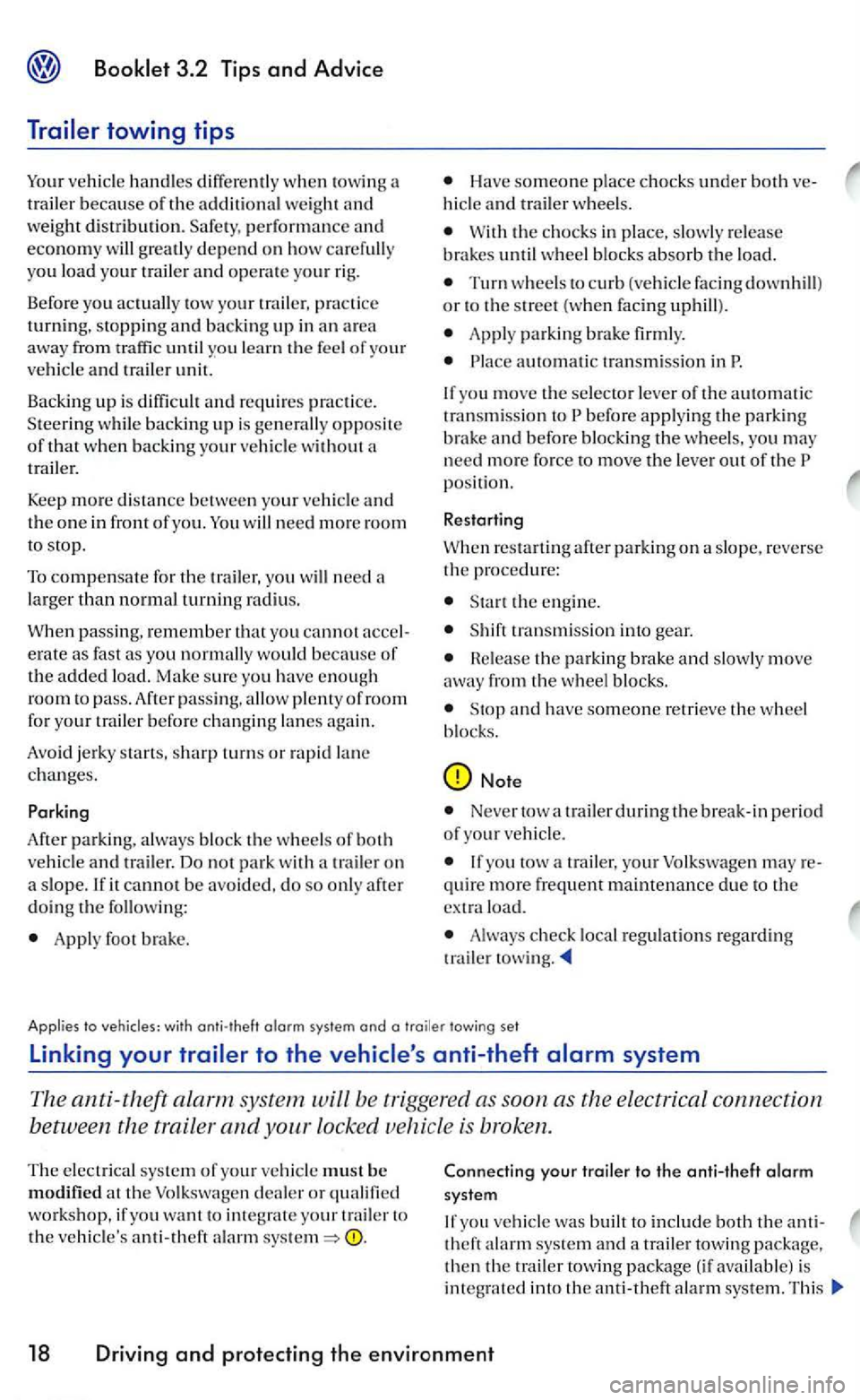
Booklet 3.2 Tip s and Advice
vehicl e handles diff ere ntl y wh en towin g a
tr ai ler because of the additional weigh t and weight distribution. Safe ty, pe rform ance and econo m y will greatl y depend on how carefull y
yo u load your trailer and op erat e your rig.
Before you actually to w your trail er, p ractic e
turning. stopping and b ack ing up in an area away from traffic until learn the feel of your vehicle and trail er unit.
Backing
up i s diffi cult and requi res practi ce.
Stee rin g whil e backing up is gen erall y opposite of that when backin g your vehicl e with out a
trailer.
Keep
more distance between your vehicl e and the one in front of yo u. will need more room to stop.
To compensate for the trail er. you will need a
larger than normal turning radius.
When passing, remember that you cannot erate as fast as you normally would because of the added load. Make sure yo u have enough
room to pass. After passing. allow plenty of room for you r trailer before c hanging lanes again.
Avoid je rk y s tart s, sharp turn s or rapid lan e changes.
Parking
After parking. always block th e wheels of both ve hicl e and trail er. Do not park with a traile r on a slope. If it cannot be a voided, do so only after doing th e follo wing:
Apply fo ot brake .
Have someone place chocks under both hicl e and trail er whee ls .
With the c hock s in place, s lo w ly re lease brak es until wheel blo cks absorb the load.
Turn w heels to curb (ve hicl e facing downhill)
o r to the stre et (when facing uphill).
Appl y parkin g brak e firmly.
automatic transmi ssion in
If you move the selecto r leve r of the automatic tran smission to
position.
Restarting
When restarting after parkin g on a slop e, reverse
the proc edure:
S tart the engine.
S hift transmission into gear.
le a se the parking brake and slowly move away from the wheel block s.
Stop and hav e someone re trie ve the wheel
b lock s.
Note
Neve r to w trailer during the break-in period of your vehicl e.
If yo u tow a trailer , yo ur Volksw age n m ay quire more frequent maimenance due to the
ext ra load.
Always check local reg ulations regardi ng
trailer to w in g.
Applies to vehicles: with anti-theft a larm system and a traile r towing set
Linking your trailer to the vehicle's anti-theft alarm system
The anti-theft alarm syste m will be triggere d as soon as the ele ctrical connec tion
between the trailer
and
or qualified
wo rkshop, if you want to inte grat e your trai le r to th e ve hicle's anti-theft a larm
Connecting your trailer to the anti-theft alarm syste m
If yo u ve hicle was built to include both the th eft al arm system and a trailer towin g th en t he trail er towing package (if available) is
in tegrated into the anti-theft alarm sys te m . Thi s
18 Driving and protecting the environment
Page 295 of 444
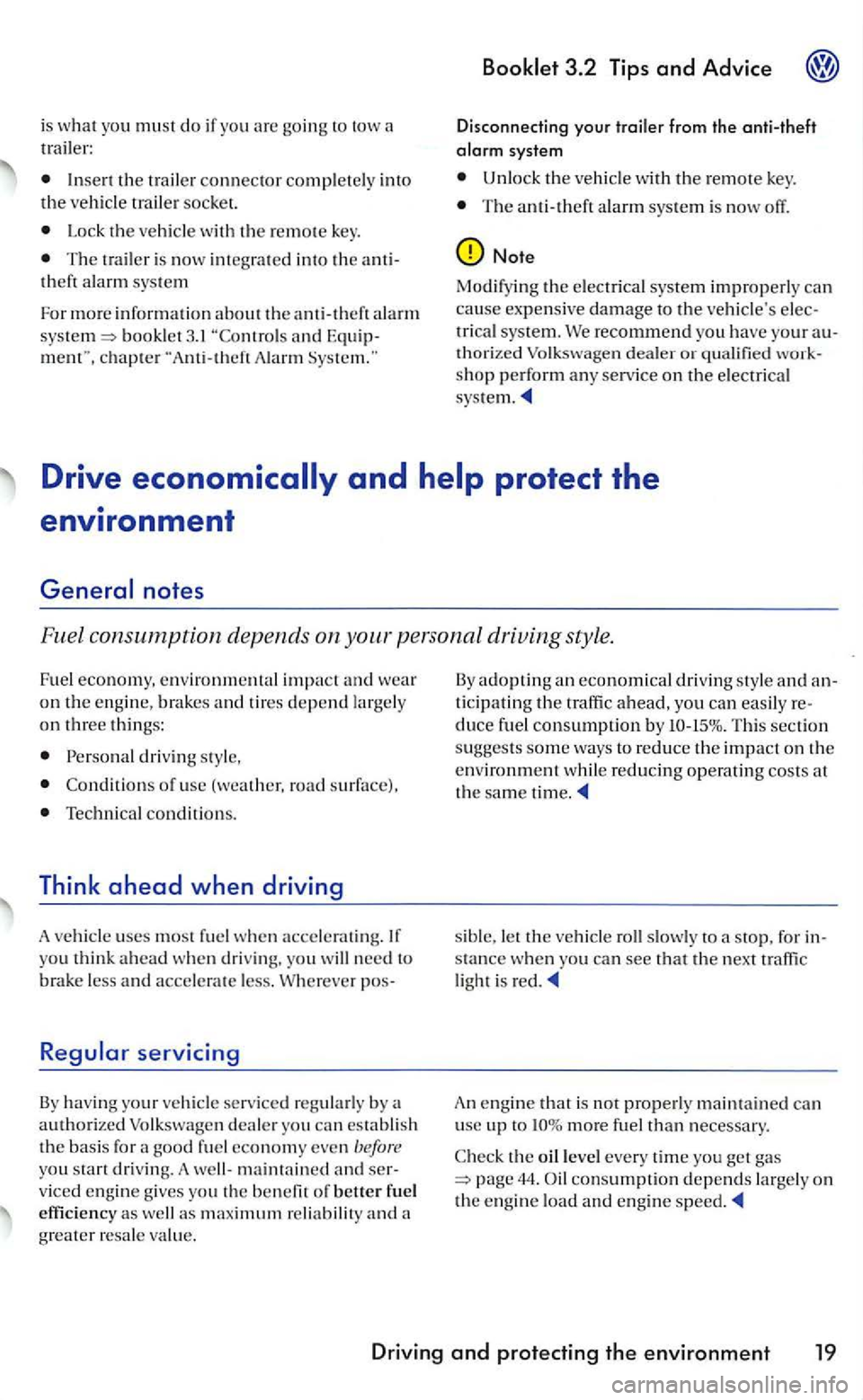
is what you mus t do if you going to tow
Inse rt the trailer connector completely into the vehicle trailer socket.
Lock th e ve hicle with the remote key.
The trail er is now integ rat ed int o th e theft alarm system
For more information about the anti-theft alarm bookl et3. 1 chapter "Anti -theft Alarm
Disco nnecting your trailer from the anti-th eft
alarm system
Unlock th e vehicle with the remote key.
The anti-theft alarm sys tem is now ofT.
Note
Mod ify ing the electrical system improperly can cause expe nsive damage to the veh icle's trical sys tem. recommend yo u have your thorized Vol kswagen dealer o r qualified
driving sty le,
Co nditions of use (wea ther, road s urface) .
Technical conditions.
Think ahead when driving
A ve hicl e uses most fuel when accel erating. If
yo u think ahead when driving. you need to brake less and accelerate less. pos-
Regular servicing
B y having your vehicle serviced regularly by a authorized dealer you can es tabl is h the basis for a good fuel economy even you start drivin g. v iced e ngine give s yo u th e be nefit of better fuel
efficie ncy as well as maximum re liabilit y and greater resale value. B
y
adopting an economica l driv ing style and ticipat ing the traffic ahead, you can easily duce fuel consumption by Thi s section sug ges ts som e w ays to reduce th e impact on th e
e nvironment while reduci ng operatin g costs at
the same
s ibl e, let the vehicle roll slo wly to a stop. for
light is
A n engine that is no t properly maintained can usc up to 10% more f uel than necessary.
the oil level every time you get gas consumption dep ends la rgely on the e ngin e load and engine
Driving and protecting the environment 19
Page 299 of 444

edges under the vehicl e can cut exposed
ski n.
Alway s protect your hands and arms from cuts on sharp m etal edges when clea ning th e underbody, the inside of th e wheel housin gs
etc.
Never try to remov e mud or dust if the vehicle dry . a dry cloth or
sponge fo r cleaning could damage th e paint or
3.2 Tip s and Advice
glass on your vehicle . dirt . mud or dust with plent y of wate r before removing it.
When rinsing the vehicle. do no t let water ge t
int o th e lock cylinders or point the hose at gaps
around the doors. hood or tail gate. The water could freeze and make it difficult to open the hicle.
To he lp preve nt damage to th e pai nt, do not was h the vehicle in direct sunl ight.
F o r th e sake of environment
To protect the environme nt. wash the vehicle
only in specia l was h bays that c an handle oily
d irt that is wash ed off th e car.
- Do nor use a power washer to remove
ic e
or snow page 25.
- Neve r use concentrated jet nozzles or
so-called
- After ve hicl e has been washed, the
brake
dis cs and pads will be we t (they
could even be icy in the win te r) and
th e brakes with seve ra l care ful brake
application s before drivin g page 13.
WARNING
brakes or bra kes coa ted with ice or road salt react slower and n eed longer stoppin g tances.
Ca re full y apply brake s for a test.
1
l ap plicab le
Always dry and cl ean off ice ings and salt coatings with a few cautious brake applicati ons.
Always rea d and heed all power and braking
WARNING
Improper usc of powe r was he rs ca n cause rious , in vis ible and perm an ent tire damage leading to tire failur e an d loss of ve hicle trol.
Never wa sh tire s wi th the water out in a direc t stream even at
temperature sh o uld not be more than F
If yo u use power wash e r. be sure to keep it a
sa fe d istance from the sors' > in the front and rear bumpers . you h old
it too to the sensors, you could damage
them.
and protection 23
Page 302 of 444
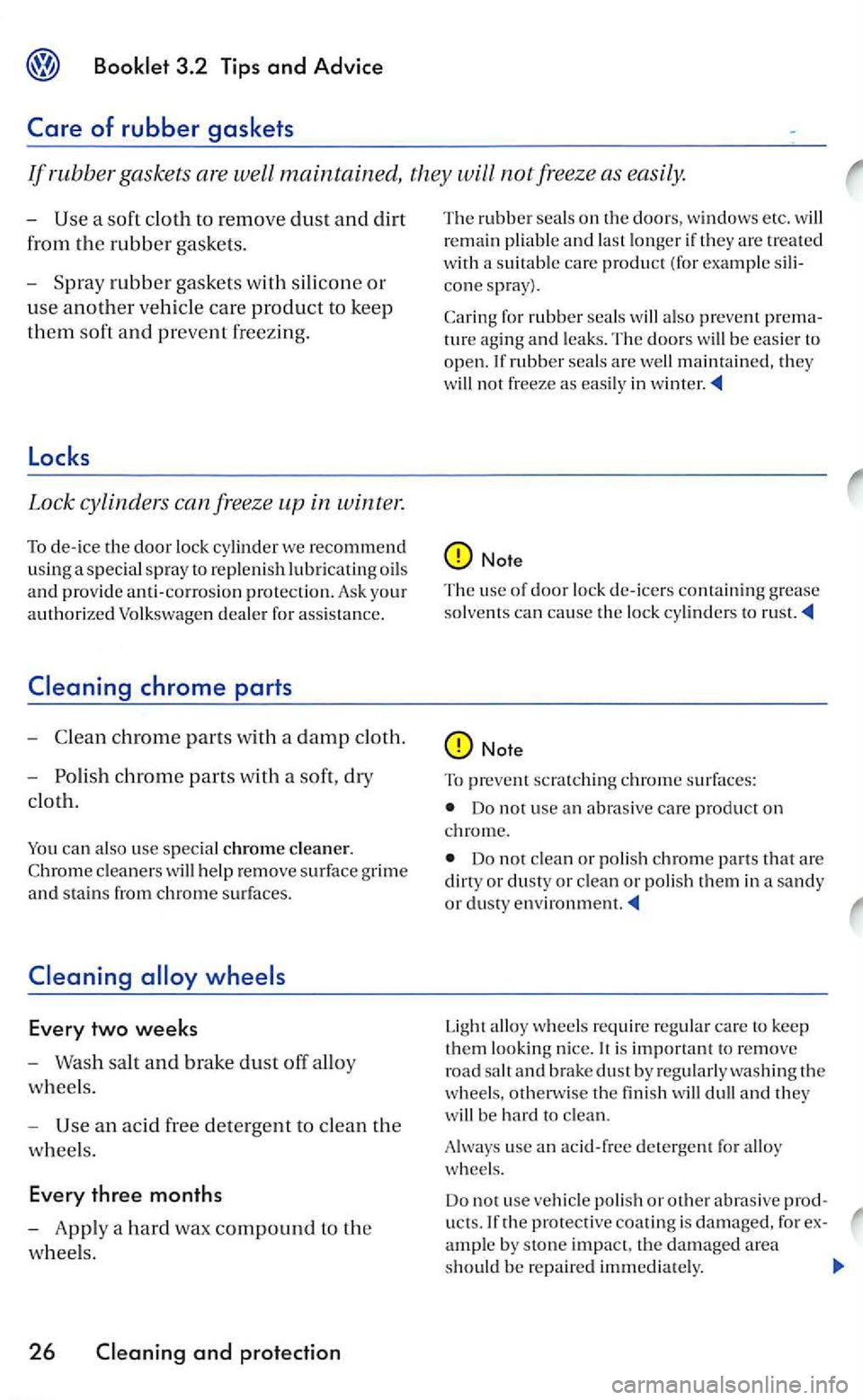
a soft cloth to re m ove dust and d irt
from
the rubber gaskets.
- Spray
rubber gaskets with silicone or
u
se another veh icle care product to kee p
them soft and p revent freez ing.
Locks
Lock cylinders can freeze up in winter.
To de-ice the door lock cylinder we recommend
using a sp e cia l spray to repl enish lubricatin g oils and pro vid e an ti- co rro sio n pro tect ion. Ask you r
authorized Volkswagen dea le r for ass istance.
ca n also use sp ecia l ch ro m e clea ner. cleaners will he lp remove surface grime and sta ins from chrome surface s.
an acid free dete rgent to clean the
w h
eels .
E very three months
- Apply a hard wax compound to the
w
heel s .
26
for rubber sea ls w ill also prevent pre mature aging and leaks. The doors will be easier to open. rubber seals are well maintained, they
will not freeze as easi ly in winter.
Note
The use of door lock de-icers contai ning grease
solvents can cause the lock cylinders to rust.
Note
To prevent scratching c hrome surface s:
Do not use an abrasive care prod uc t o n
chrome.
Do not clea n or polish chrome pa rts that are
dirty or dusty or clean or polis h them in a sandy or dusty environment.
Light alloy wheels require reg ular care to keep them look ing nice. is impor tant to remove
road salt and brake dust by regularly wash ing th e
wheels, other w ise th e finish will be hard to clean.
Always use
an acid-free detergent for alloy
w heels.
Do not use vehicle polish
or other abras ive prod
ucts. the protective coating is damaged, for example by stone im pact. the damaged area should be repaired immediately .
Page 311 of 444
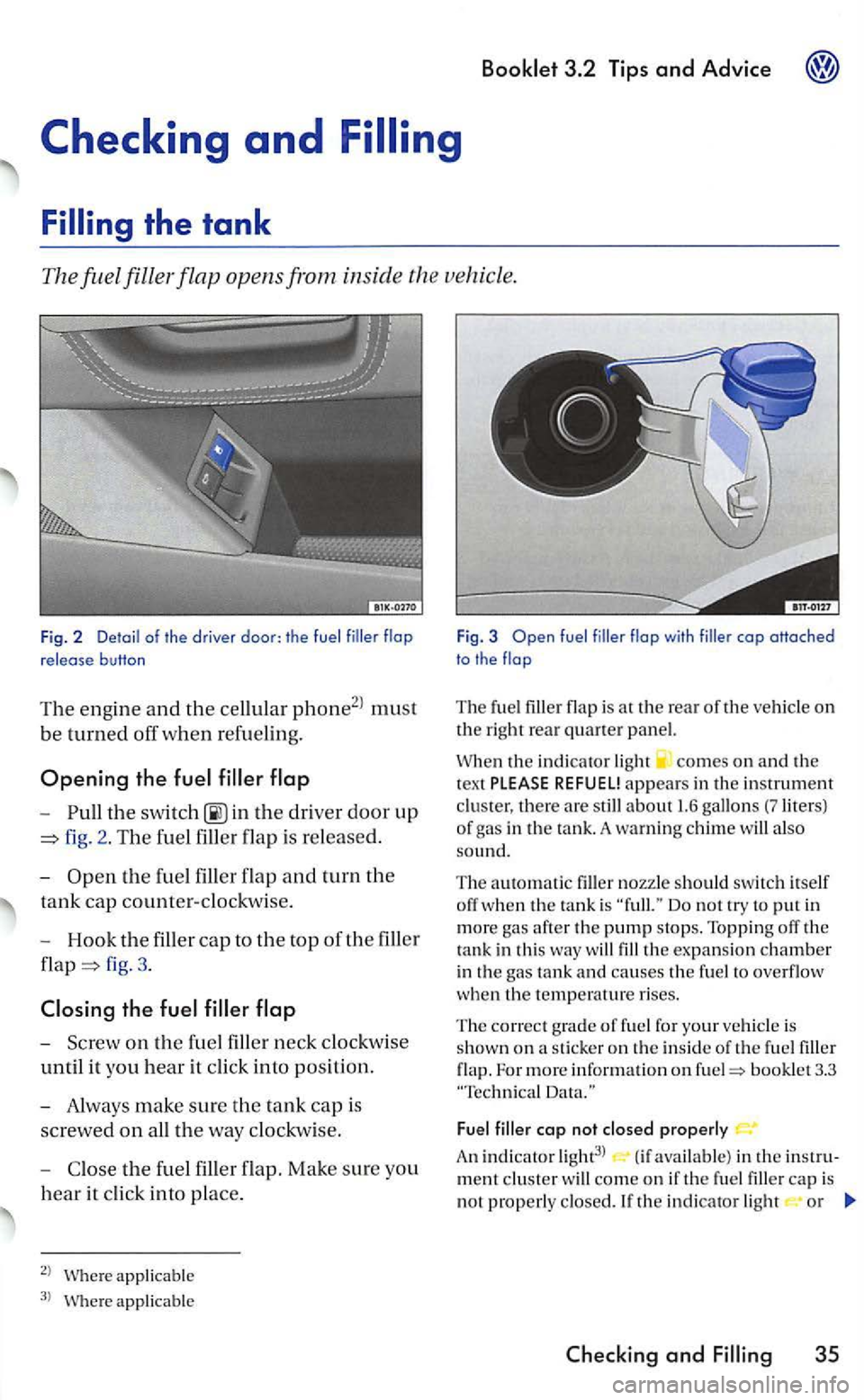
-in the driver door up
fig. 2. T he fuel filler flap is re leased.
-
Open t h e f uel filler flap and turn the
tank cap counter-clockwise.
- Hook
the fille r cap to the top of th e filler
fig. 3.
the
-Screw o n the
applicable
applic able
Fig . 3 fue l flop with cop oHoched
to the
The fu el flap is a t the rear of the vehicle on the right rear quarter panel.
th e indi cator light comes on and th e
t ex t PLEASE REFUEL! appears in the in strume n t
clu ster, there are s till ab out 1.6 gallo ns (?liters) of g as in the tank. A warning ch im e will also so und.
The automatic nozzle shoul d swi tc h itself off w hen the ta nk is
the expansion chamber
i n the gas ta nk and causes the fuel to overflo w when the temperature rises.
T
he correct g rade of fu el for your vehicle is
show n on a stick er o n th e inside of the fu el flap. For m ore informatio n on bookle t 3.3
Fuel filler cop not closed prope rl y
A n in d ic a to r light3l (if available) in the
Checkin g and 35
Page 316 of 444
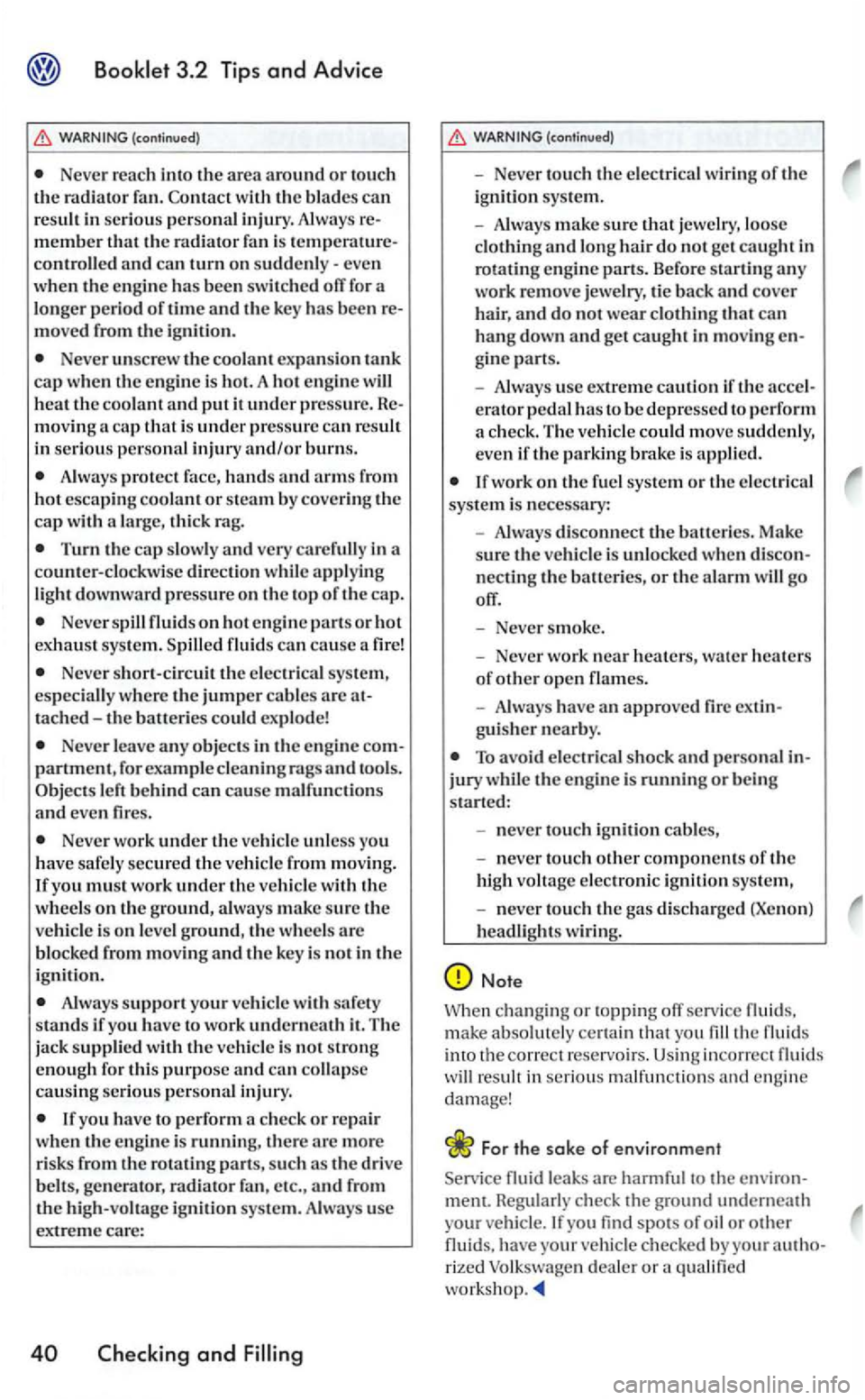
WARNING (continued)
Never reach into the area around or tou ch the radiator fan. Contact w ith the blade s can resuh in se riou s personal injury. Always m ember that the radiator fan is controll ed and can turn on
m oved from the ignit ion.
Never unscrew the coolant expa nsio n tank cap when th e engin e is hot. A hot engine will heat the coo la nt and put it under pressure . mov in g a cap that i s under pressure ca n rcsuh in seriou s personal injury and/or burns.
A lway s prote ct face, hand s and arms from hot esca ping coolant or steam b y cove ring the ca p with a large, thick rag.
Turn the cap slow ly a nd very carefully in a
counter- clo ckw ise direction whil e applying
light downward pressure on the top of the cap.
Never spill on hot engine parts o r hot
e xhau st sys te m . S pilled
Neve r short-circuitthc elec trica l sys te m ,
es peciall y w here th e jumper cabl es are tached -th e balleri es could explode!
Neve r leave any objects in the e ngine partment, for exam ple cleaning rag s and too ls. Objects
Neve r work unde r the veh ic le unless you
h ave safely secured th e ve hicl e from movin g.
I f yo u must work under th e ve hicl e wit h th e
w hee ls on th e ground, always make sure the vehicl e is on leve l ground, th e wh eels arc
b locked from movin g and th e key is not in the
ignition.
Always support your ve hicle with safety
s tands if you have to wo rk underneath it. The
ja ck suppli ed with the ve hicle is not s tron g enough for this purpose and can co llap se causin g se riou s personal injury.
If you have to perform a check or r ep a ir
w hen th e e ngine is running, there arc more
ri sks from
the ro tating parts, such as the drive
WARNING (con tinued)
Neve r to uch the e lec tr ica l w ir in g of the ig ni tio n sys tem.
Always make sure that j ewe lry, loose clothing and lo ng hair do not get caught in
rota ting engine pans. Before startin g any work remove jewelry, tie back and cover
hair, and do not wear clothing that can hang down and get caught in mov ing gin e parts.
Always use extre me cauti on if the erator pedal has to be depresse d to perform
a ch eck. The vehicle could move suddenly, eve n if the parking brake is applied.
If wor k on the fu el sys te m or th e electrica l
syste m is necessa ry:
Always discon nect th e balleries. Make
sure th e vehicle is unlo cked when
Neve r sm oke .
Neve r work nea r heaters, wa te r h eaters of other open names .
A lways have an approve d fire ext guis her nearby.
To avo id electrical shock and personal jury w hil e the eng ine is running or being
s tarted :
n ever touch ignition cables,
never to uch othe r component s of the
high vohage electronic ignition syste m,
never touch the gas discharged (Xeno n) headlights wiring.
Note
Whe n chang ing or topp ing orr service fluids. make absolutel y ce rtain that you fill the fluid s
into the corr ect reservoirs. Using incorrec t fluids will resuh in serious malf unct ions and engine
damage!
For the sake of environment
Service fluid leaks are harmful to the environ-
ment. Reg ularl y check the ground undernea th
your vehicle . you find spots of oil or other
fluids. have your vehic le checked by your rized dealer or a qualified
Page 317 of 444
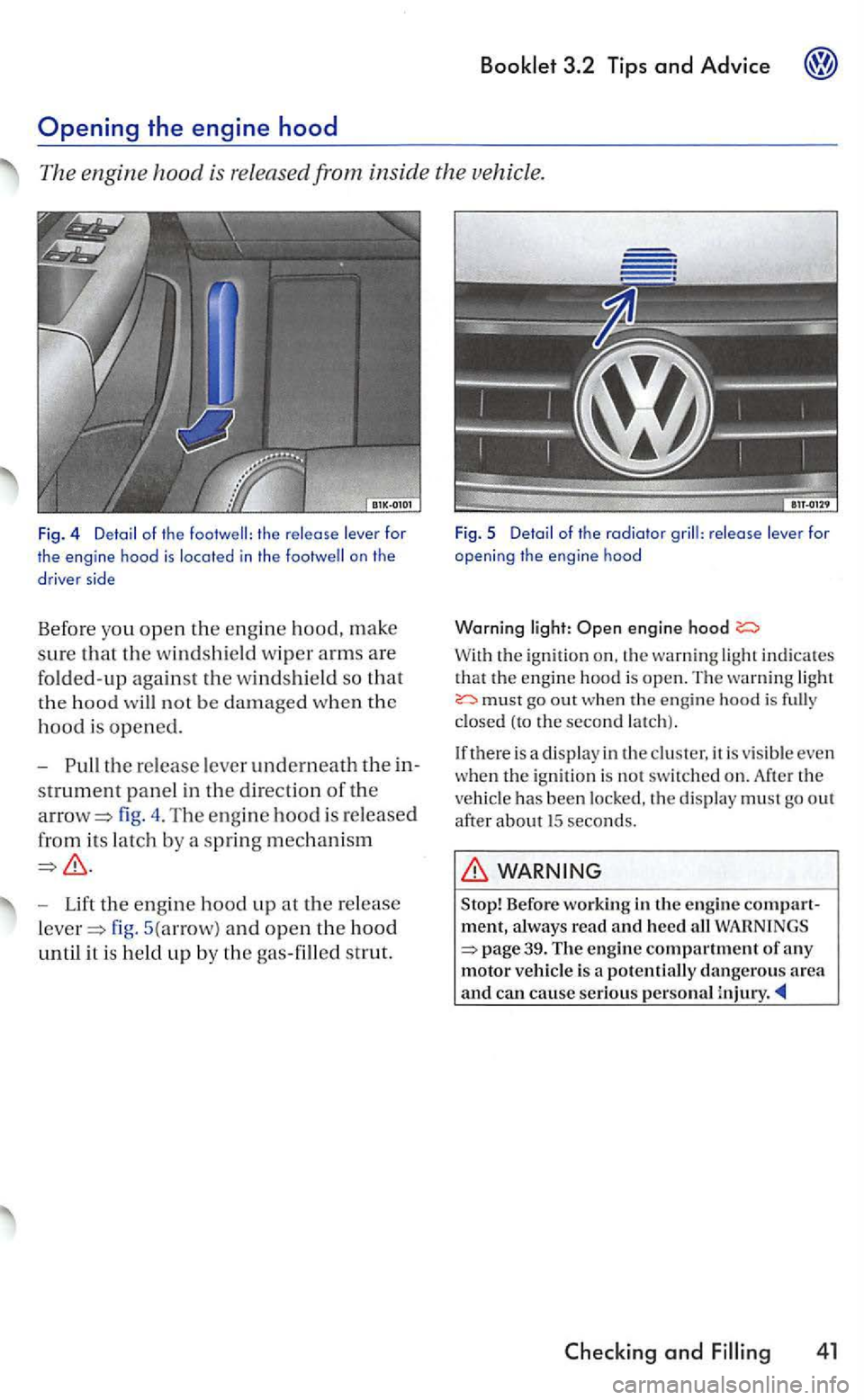
Booklet 3.2 Tips and Advice
th e release lever for
the engine hood is located in the on the
d rive r side
Befor e you open the engine hood, make
sure that the w indshi eld wiper arms are
folded-up against the winds hi eld so that
the hood will not be damaged when the
hood is opened.
fig . 4 . The engi ne hood is released
from its latch by a s
pring mechanism
Lift the engin e hood up at the re lease
fig. 5(arrow) and open the hood
until it is held up by the gas-filled strut.
Fig . 5 Detail of the radiator release lever open ing the en gine hood
Warning engine hood
With the ignition on, the warnin g light indicate s
that the engine hood is open. The warning light must out when the engine hood is closed (to the second latch ).
If there is a displa y
in the cluster, it is visible even
when the ignit io n is not switched on. After the
vehicle has been locked, the disp lay must go out after about 15 seconds .
WARNING
Before working in lhe engine compartment, always read and heed all WARNINGS 39. The engine compartment of any motor vehicl e is a potentially dangerous area and can cause se riou s personal injury.
Page 318 of 444

the engine hood down th e
pressure fro m the strut is reduced.
- Then the en g in e hood
in
If the engine hood does not close properly, open
it agai n and close it properly. the engi ne
hood i s yo u can sec that it fits with the other body pans.
Engine
If the en gin e hood is not closed prope rly, it could up and block your while driv ing cau sing a crash and serious person a l injuries.
Afte r closing the engine hood, always
c heck that the latch has properly gaged. The engine hood must be with the
surrounding body p a rts.
If you ever n otice that the engin e hood latch is not properl y secured w he n the vehicl e
i s mov in g, stop at once and close it.
Neve r le t anyone get in the way of the gine hood when clos in g
Th e engine oil use d co nform to exact specifications.
en g in e was with an meets
can usc thi s oil over all ature ranges for normal driving.
If you need to add between oil changes, use only a hi gh synt hetic-based oil w ith rect specificatio ns that express ly complies with oil qua li ty standard gine oil v iscosity grade is able. yo u can also use as long as it meets oil quality standard
arc synthetic engine oils. This does no t mean, however, that every synthetic engine oil will meet
and
always be sure that yo u u se an
th e term s must appear o n the oil container si ngly o r
in combination w ith other designations:
Gasoline engine
General recommendations
or